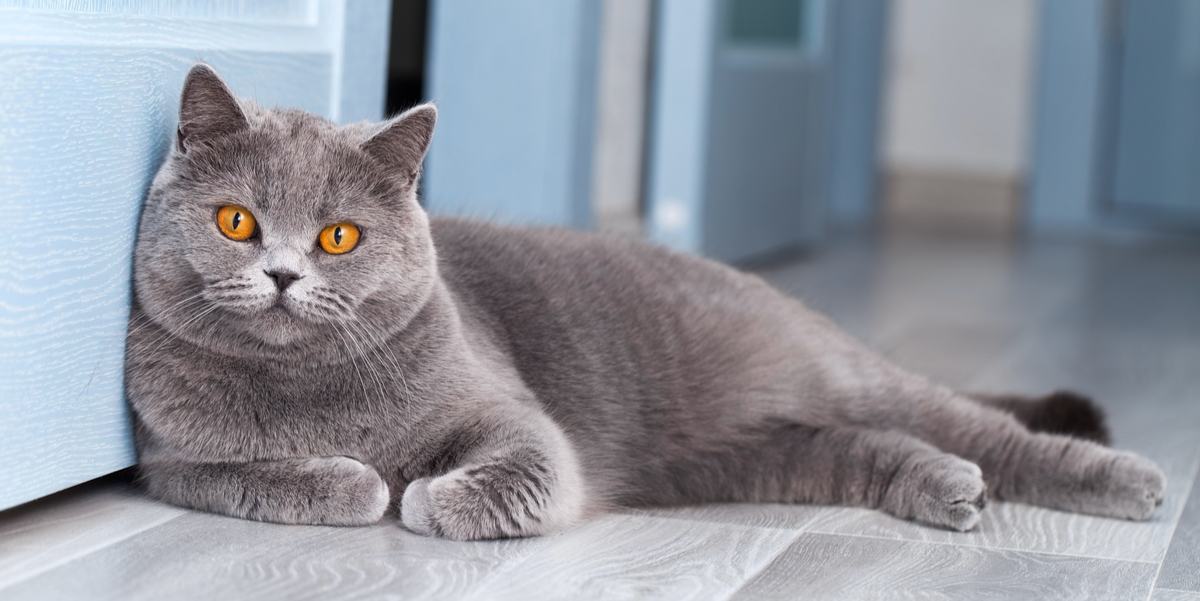
Though grey is one of the most beautiful colors found in cats, grey cats are not particularly rare. The color grey, which is also called blue, is a dilute variation of black, which is a very common color in cats.
In cats, grey coats come in a range of hues, from very light silvery grey to deep slate blue. Grey cats also come in a variety of different patterns, including solid grey, grey tabby, grey spotted tabby, grey ticked tabby, grey spotted, grey pointed, and bi-colored (grey with white).
The dilute versions of calico and tortoiseshell cats also have some grey color in their coats, but in these coat patterns, grey is mixed with orange or tan (tortoiseshell) or orange/tan and white (calico).
Also Read: Tortoiseshell Versus Calico Cats: What’s The Difference Between Them?
Some cat breeds only come in grey or blue, such as the Chartreux, Korat, Nebelung, and Russian Blue. Other popular cat breeds come in grey or blue, but also appear in other colors, whether solid or patterned.
Some breeds do not come in grey at all, including the Bombay, Burmilla, Havana Brown, Japanese Bobtail, Khao Manee, Ragdoll, Siamese, Singapura, and Tonkinese.
Many of the pedigreed cat breeds recognized by the Cat Fanciers Association and The International Cat Association come in grey or blue. Read on to learn about some of the most popular grey cat breeds.
#1 British Shorthair
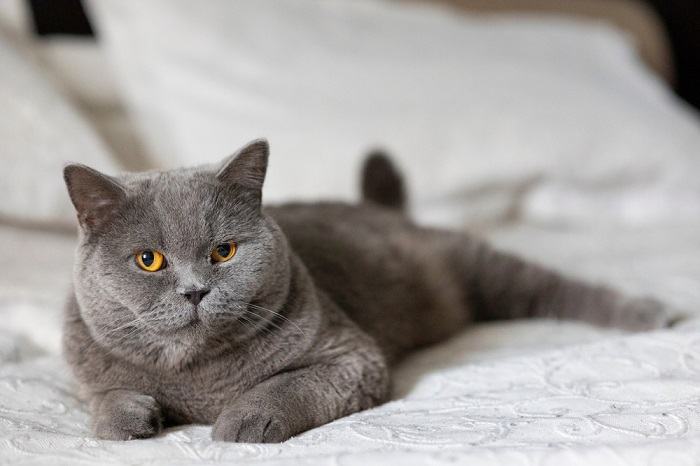
The British Shorthair of today comes in a rainbow of colors, but when the breed was first developed, most British Shorthairs were blue (grey). In fact, there were so many blue British Shorthairs that the breed was originally called the British Blue. Today, blue remains a popular color in the British Shorthair.
Today’s British Shorthairs come in several grey colors and patterns, including solid blue, blue tabby, silver tabby, and bi-color (blue and white). The British Shorthair’s single coat is short and very dense. British Shorthairs are laid-back and affectionate, and get along well with kids and other pets, including friendly dogs.
#2 Burmese

The Burmese comes in four colors, two of which are grey hues: blue, which is a medium gray, and platinum, which is a pale, light grey. (The other two Burmese colors are in the brown family: sable, which is a rich, warm, sable brown, and champagne, which is a warm honey beige.)
These four colors come from the Siamese cat, which was used in the development of the Burmese breed. The Burmese’s coat is very short and sleek, with a fine, glossy, satiny texture. The coat requires very little grooming. The Burmese is extremely people-oriented and affectionate, and wants to be with its favorite people always.
#3 Chartreux
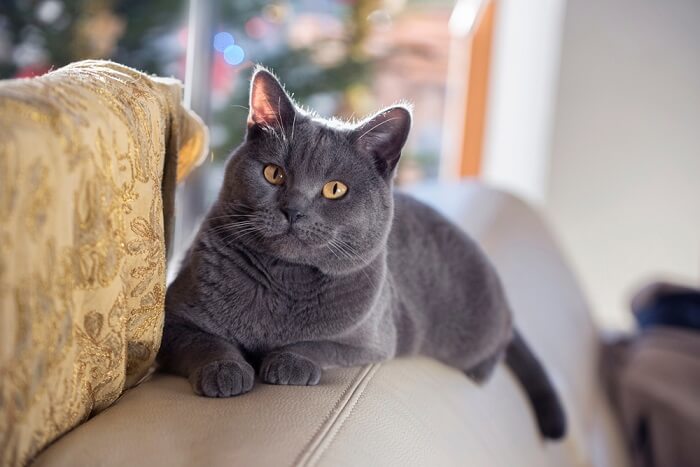
The Chartreux developed naturally in France hundreds of years ago, though it was cultivated later on, starting in the 1920s. The breed is always blue, which may be any shade of bright, unblemished blue-gray from ash to slate. The ends of the hairs are tipped with silver, which gives the coat the appearance of an iridescent sheen.
The medium-short double coat has a unique texture. It’s slightly woolly and breaks at neck, chest and flanks like sheep’s wool. The Chartreux’s eyes range from copper to gold, with a brilliant orange preferred. Chartreux cats are gentle, quiet and friendly, and enjoy playing with their favorite people.
#4 Egyptian Mau
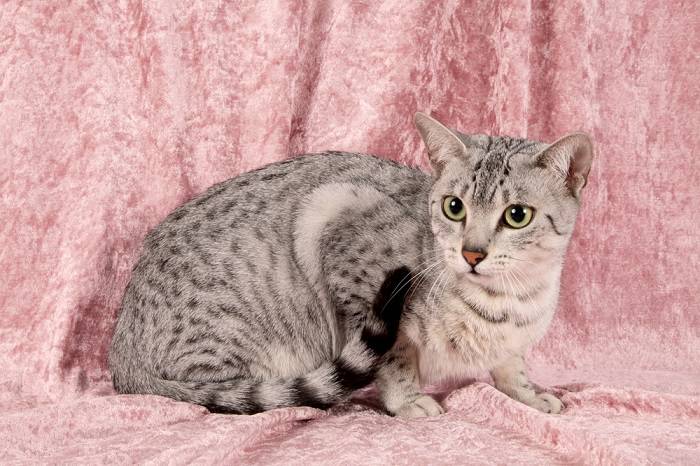
The exotic-looking Egyptian Mau is the only naturally spotted breed of domestic cat. The Egyptian Mau’s spots may be small or large, round, oblong, or irregular shaped. The breed also has an “M” and frown marks on the forehead, a dorsal stripe along the back, a banded tail and dark tail tip.
The haunches and legs have both spots and stripes. The Egyptian Mau’s medium-length coat has a lustrous sheen. Though the Egyptian Mau comes in several colors, the grey-hued silver, a warm bronze, and smoke colors are perhaps the best recognized.
The Egyptian Mau’s bright-green eyes are quite striking, a color that’s referred to as “gooseberry green” in the breed standard. Egyptian Maus are friendly with their own humans, but can be shy with newcomers.
#5 European Burmese

The European Burmese is closely related to the Burmese. In fact, the two breeds can trace their origins back to the same cat—Wong Mau, the first cat to be called a Burmese who was used in breeding programs in the 1930s. Some descendants of these breeding programs continued to be bred in the United States, while others made their way to the United Kingdom.
Slight differences in the breed emerged in the two different parts of the world and today the Burmese and European Burmese have slightly different looks and separate breed standards. The Burmese comes in just four colors, but the European Burmese comes in more.
The grey hues include blue (a soft, silver blue-gray) and blue-cream (blue-gray and cream with color patches). European Burmese are intelligent, affectionate and extremely companionable.
#6 Korat
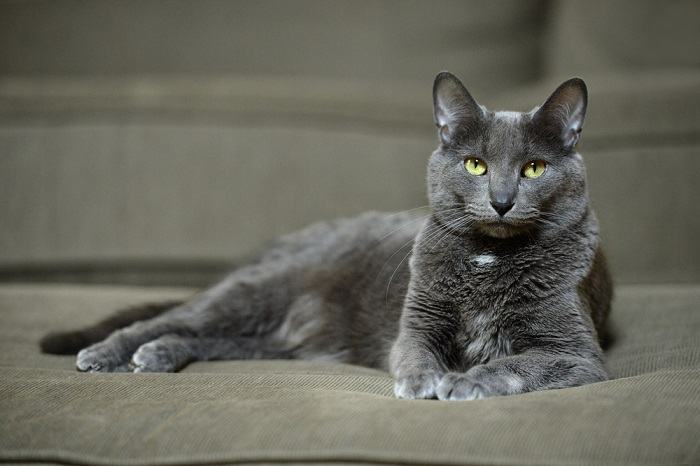
The Korat is an ancient breed that developed in Thailand. This rare breed was one of the “good luck” cats featured in the Cat-Book of Poems (Smud Khoi of Cats), which was written sometime between 1350 and 1767. Korats are blue tipped with silver, which creates a silver halo effect. The short coat is glossy and fine, and lies close to the body.
The Korat has a unique, heart-shaped head with wide-open eyes that seem oversized for the cat’s face. Though luminous green eyes are preferred by the breed standard, amber colored eyes are also acceptable. Korats are active but gentle, and love to cuddle.
#7 Nebelung
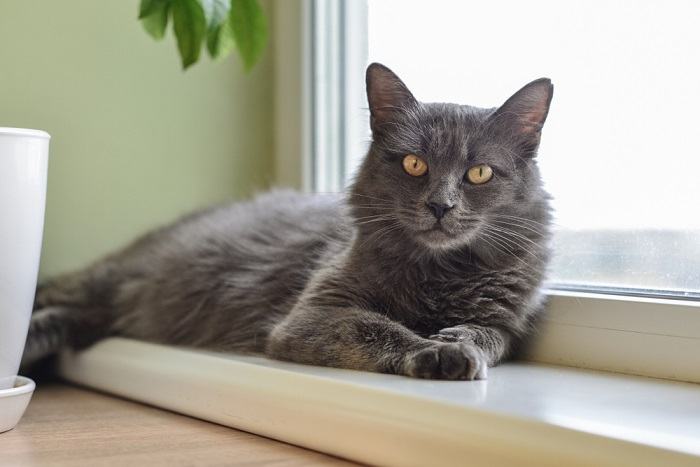
The Nebelung is a relatively new breed, created in the 1980s by a cat breeder named Cora Cobb. The breed is a semi-longhaired blue cat, meant to resemble the Russian Blue in all ways except the length of the hair (Russian Blue cats have short coats). Although the foundation cats for the new Nebelung breed were not Russian Blues, outcrossing with Russian Blues helped to solidify the breed (outcrossing Russian Blues and Nebelungs is still permitted).
The breed name comes from the German word nebel, which means fog. The Nebelung’s coat is solid blue, with a lustrous sheen and preferably, silver tipping. The Nebelung cat is very attached to its own family, but may be shy with strangers, especially at first.
#8 Russian Blue
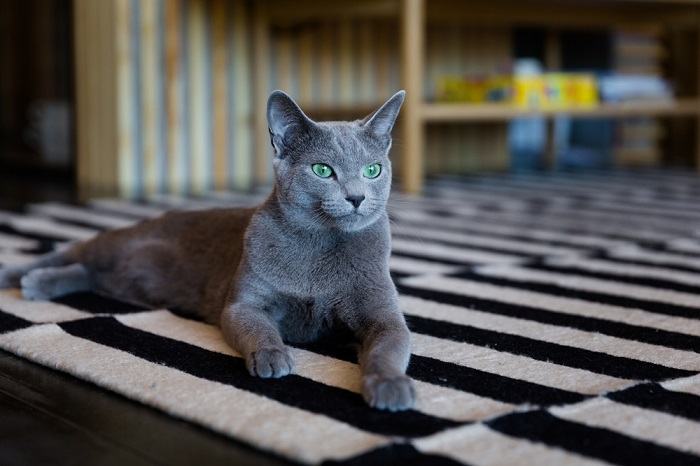
As the breed name implies, the Russian Blue hails from Russia and is always a blue-grey color. The color of a Russian Blue is a solid, even, bright blue with lighter shades preferred over darker shades. Russian Blues also have silver-tipped guard hairs (the longer hairs of the outercoat), which makes the cat look as though it has a silvery sheen or sparkling luster.
The short, dense, fine, and plush coat stands out from the body and is very soft and silky to the touch. The unique, silvery blue coat combined with the breed’s trademark emerald green eyes make the Russian Blue one of the most strikingly beautiful cats in the entire feline realm. Russian Blues are gentle, quiet and very affectionate lap cats, though they can be reserved with strangers.



